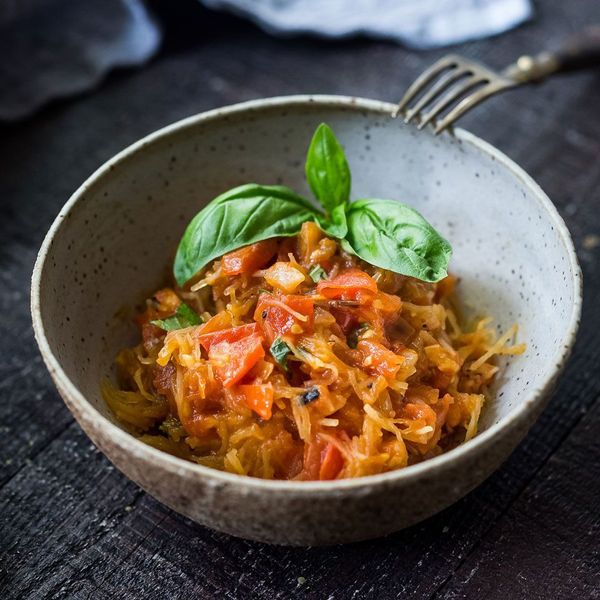
Swapping spaghetti squash for pasta is a great way to cut back on carbs and calories in this saucy vegan dinner. Here, we have tossed the squash with a simple fresh tomato sauce. Jazz up the sauce with crushed red pepper flakes, Kalamata olives and/or capers, if you like.
Updated on April 19, 2024
Cook Mode
(Keep screen awake)
Ingredients
-
1 medium spaghetti squash (4-5 pounds), cut in half, seeds removed
-
3 tablespoons extra-virgin olive oil
-
⅔ cup chopped onion
-
4 garlic cloves, minced
-
2 pounds ripe tomatoes, diced (about 4 cups; save juices)
-
¼ cup vermouth, dry red wine or dry white wine
-
½ teaspoon ground pepper
-
¼ teaspoon salt
-
8-10 fresh basil leaves, torn
Directions
-
Preheat oven to 425 degrees F. Line a rimmed baking sheet with parchment paper.
-
Place spaghetti squash halves, cut-side down, on the prepared baking sheet. Bake until the squash is tender when pierced with a knife, 40 to 50 minutes.
-
Meanwhile, heat oil in a large skillet over medium-high heat. Add onion and cook, stirring often, until fragrant and starting to soften, 2 to 3 minutes. Reduce heat to medium. Add garlic and continue cooking until golden, about 2 minutes. Add tomatoes and their juices. Increase heat to medium-high. Add vermouth (or wine) and cook, stirring occasionally, until the tomatoes begin to break down, 4 to 5 minutes. Stir in pepper and salt. Reduce heat to low and simmer for 5 minutes. Remove from heat and cover.
-
When the squash is cool enough to handle, use a fork to scrape the flesh from the shell; add it to the tomato sauce. Stir in basil.
Originally appeared: Eatingwell.com, September 2018
Nutrition Facts (per serving)
| 268 | Calories |
| 12g | Fat |
| 37g | Carbs |
| 5g | Protein |
| Nutrition Facts | |
|---|---|
|
Servings Per Recipe 4 |
|
|
Serving Size 2 cups |
|
|
Calories 268 |
|
| % Daily Value * | |
|
Total Carbohydrate 37g |
14% |
|
Dietary Fiber 9g |
30% |
|
Total Sugars 17g |
|
|
Protein 5g |
10% |
|
Total Fat 12g |
15% |
|
Saturated Fat 2g |
9% |
|
Vitamin A 2368IU |
47% |
|
Vitamin C 47mg |
52% |
|
Folate 68mcg |
17% |
|
Sodium 322mg |
14% |
|
Calcium 115mg |
9% |
|
Iron 2mg |
12% |
|
Magnesium 71mg |
17% |
|
Potassium 1028mg |
22% |
Nutrition information is calculated by a registered dietitian using an ingredient database but should be considered an estimate.
* Daily Values (DVs) are the recommended amounts of nutrients to consume each day. Percent Daily Value (%DV) found on nutrition labels tells you how much a serving of a particular food or recipe contributes to each of those total recommended amounts. Per the Food and Drug Administration (FDA), the daily value is based on a standard 2,000 calorie diet. Depending on your calorie needs or if you have a health condition, you may need more or less of particular nutrients. (For example, it’s recommended that people following a heart-healthy diet eat less sodium on a daily basis compared to those following a standard diet.)
(-) Information is not currently available for this nutrient. If you are following a special diet for medical reasons, be sure to consult with your primary care provider or a registered dietitian to better understand your personal nutrition needs.

Leave a Reply